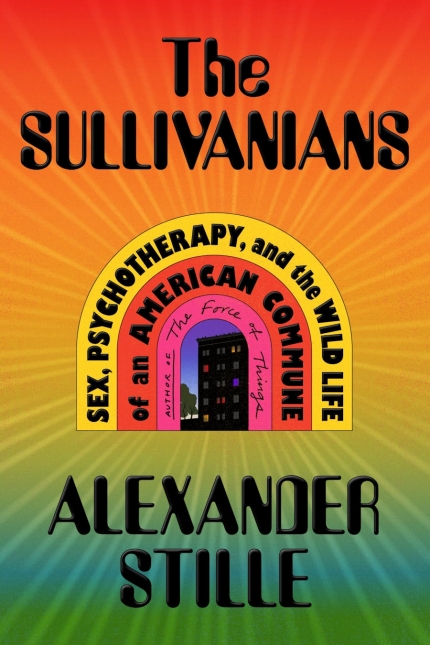The Sullivanians: Sex, Psychotherapy, and the Wild Life of an American Commune
- By Alexander Stille
- Farrar, Straus and Giroux
- 432 pp.
- Reviewed by Lisa Guidarini
- July 10, 2023
How a family-eschewing cult took root in Manhattan.

Whether it was a communist cult or an innovative social experiment depends on whom you ask: those looking back fondly on a period of free love and social experimentation, or the virtual orphans traumatized by intimidation and abuse.
From the mid-1950s to 1991, between the introduction of the Pill and the AIDS epidemic, a free-love cult operated on the Upper West Side of Manhattan — hidden in plain sight. Well-known psychiatrist Jane Pearce, a former student of neo-Freudian pioneer Harry Stack Sullivan, formed the Sullivan Institute for Research in Psychoanalysis along with her husband, Saul Newton. Established on the idea that the nuclear family was the root cause of most psychological problems, this largest urban commune in the U.S. operated for 35 years as a utopian experiment centered on therapy as a means of re-engineering the meaning of “family.”
Ultimately, a cheeseburger would bring it all crashing down.
Author Alexander Stille credits the growing prestige of psychoanalysis with the group’s emergence in the 1950s. Psychiatrists, unencumbered by professional regulations, felt free to experiment with real people, showing little concern about the results. While mid-20th-century America celebrated the wholesome, traditional family unit, a counterculture was emerging, an expression of restlessness evidenced by the publication of works like Allen Ginsberg’s Howl and Jack Kerouac’s On the Road.
The Kinsey Reports of 1948 and 1956 also pulled back the covers, as it were, revealing a surprisingly complex American sexuality at odds with its buttoned-down image. Americans, Stille asserts, wanted more but felt powerless to get it. Identifying a lucrative disconnect, Pearce and Newton seized the opportunity to take therapy to the next level.
Sullivanian therapists convinced patients that biological parents were simultaneously unimportant and damaging, suppressing their children’s deepest desires and spontaneity. Separated from the outside world, members lived together as unrelated family units in large group apartments — a sort of organized chaos.
Frequent, random sex with multiple partners was the rule; exclusive relationships were forbidden. Children were raised collectively by unrelated babysitters and later sent off to boarding schools where they were miserable and, not infrequently, abused. Because mothers were forced to have several men involved in impregnating them, it would take the ready availability of DNA testing decades later to help these children figure out who their biological fathers were.
Newton forced out co-founder Pearce after their divorce, becoming what Stille describes as a toxic narcissist, an increasingly authoritarian leader who shifted the group from an idealistic, socialist collective to a virtual Orwellian groupthink camp. Patients who’d thrown their money into the collective for the common good witnessed their leader building a country house for his family alone. The Sullivan Institute had become little more than a pyramid scheme.
It was AIDS that proved to be the tipping point. Already a largely insular group, the Sullivanians’ fear and uncertainty about how the disease was transmitted prompted leadership to prohibit members from having sex with anyone from the outside. As a polygamous society, it proved a sound decision; only one member would die from the disease.
The cult’s leadership then took it even further, declaring no one from the group could eat food prepared by outsiders, a decision that would inadvertently spell the beginning of the end when therapist Michael Cohen, the assumed heir apparent to Newton, asked a friend and fellow therapist to defy the rule and join him in sneaking out for a meal. The sworn secrecy over this rebellion became known as the “cheeseburger oath.”
The two men took an extraordinary step in openly discussing their growing concerns over the increasingly unethical practices they found themselves forced into, including breaking up couples, manipulating which patients were allowed to have children and with whom, and overlooking the fact other, unscrupulous therapists — including Newton — regularly forced female patients to have sex with them as part of their “sessions.” The uncertainty and fear surrounding the AIDS virus compelled Cohen to reconsider his dedication to an organization that had been his entire world for more than a decade. Ultimately, he left.
After his departure, there was a sort of awakening, and the commune began breaking up. As they left, a few members started telling their stories, and journalists began showing up outside the building. The enigmatic Sullivan Institute for Research in Psychoanalysis was a secret no longer.
Through dozens of interviews with past members and his own exhaustive research, Stille writes an engaging book so incredible it reads like fiction. Personal recollections are shared in a raw, honest way; the author is sensitive to the reality that these well-intentioned people came seeking happiness and gave themselves over, heart and soul, to a leadership that took advantage of them. Stumbling out like Rip Van Winkle from his 20-year nap, they were forced to assimilate back into a now-unfamiliar mainstream life, often navigating it without the support of the family and friends cut out of their lives decades before. The Sullivanians is a powerful reminder of how cults operate, why they can be so seductive, and the devastation they leave behind.
Lisa Guidarini is a freelance writer and book reviewer based in Chicago. Follow her on Twitter at @Bluestalking.

